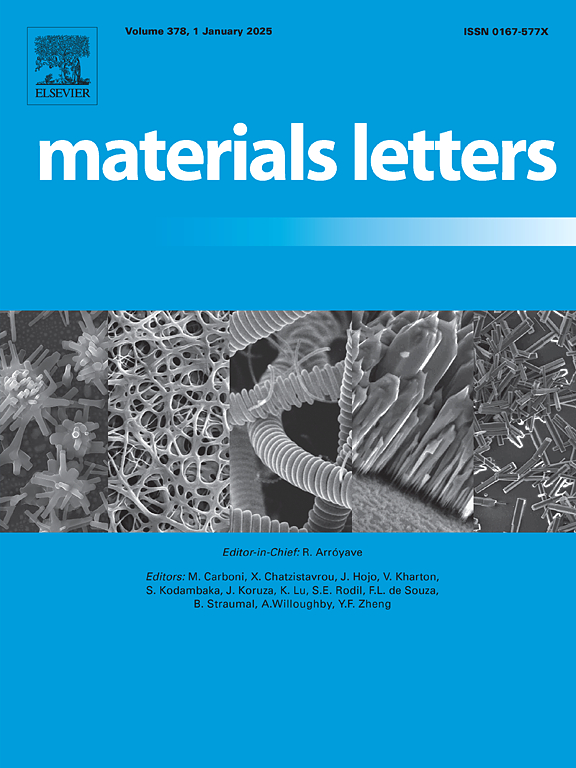Synthesis and properties of silicon-doped polyarylates with high heat resistance and low dielectric constant
IF 2.7
4区 材料科学
Q3 MATERIALS SCIENCE, MULTIDISCIPLINARY
引用次数: 0
Abstract
Polyarylates (PARs) with high heat resistance and low dielectric constant are increasingly demanded in advanced electronic applications. In this work, a series of novel silicon-doped PARs were successfully synthesized via phase-transfer catalyzed interfacial polycondensation using 9,9-bis(4-hydroxyphenyl)fluorene and 2,6-naphthoyl dichloride as monomers, with the addition of sodium silicate nonahydrate. The chemical structures of the products were confirmed by spectroscopic analyses. Due to the synergistic effect of rigid naphthalene and fluorene units, the synthesized silicon-doped PARs exhibited high thermal stability with glass transition temperatures up to 366.9 °C. The modified PARs maintained good optical transparency with transmittance above 62 % at 400 nm. The materials also demonstrated good solubility in common organic solvents, which facilitated solution processing. Furthermore, these PARs showed inherently low dielectric properties, and the incorporation of sodium silicate further reduced the dielectric constant to as low as 2.24 and dielectric loss to 0.0061 at 1 MHz through the formation of Si-O-Si networks with low polarization characteristics. This facile modification approach provides a promising strategy for developing high-performance specialty engineering plastics suitable for demanding electronic and optical applications.
高耐热低介电常数掺硅聚芳酯的合成与性能研究
具有高耐热性和低介电常数的聚酰亚酯(PARs)在先进电子应用中的需求越来越大。本研究以9,9-双(4-羟基苯基)芴和2,6-二氯化萘为单体,加入非水合硅酸钠,通过相转移催化界面缩聚成功合成了一系列新型掺硅PARs。通过光谱分析证实了产物的化学结构。由于刚性萘和芴单元的协同作用,合成的掺硅par具有较高的热稳定性,玻璃化转变温度高达366.9℃。改性后的par在400 nm处保持了良好的光学透明度,透过率在62%以上。该材料在普通有机溶剂中也表现出良好的溶解性,有利于溶液加工。此外,这些par具有固有的低介电性能,硅酸钠的掺入进一步通过形成具有低极化特性的Si-O-Si网络将介电常数降至2.24,介电损耗降至0.0061。这种简单的改性方法为开发适用于苛刻的电子和光学应用的高性能特种工程塑料提供了一种有前途的策略。
本文章由计算机程序翻译,如有差异,请以英文原文为准。
求助全文
约1分钟内获得全文
求助全文
来源期刊

Materials Letters
工程技术-材料科学:综合
CiteScore
5.60
自引率
3.30%
发文量
1948
审稿时长
50 days
期刊介绍:
Materials Letters has an open access mirror journal Materials Letters: X, sharing the same aims and scope, editorial team, submission system and rigorous peer review.
Materials Letters is dedicated to publishing novel, cutting edge reports of broad interest to the materials community. The journal provides a forum for materials scientists and engineers, physicists, and chemists to rapidly communicate on the most important topics in the field of materials.
Contributions include, but are not limited to, a variety of topics such as:
• Materials - Metals and alloys, amorphous solids, ceramics, composites, polymers, semiconductors
• Applications - Structural, opto-electronic, magnetic, medical, MEMS, sensors, smart
• Characterization - Analytical, microscopy, scanning probes, nanoscopic, optical, electrical, magnetic, acoustic, spectroscopic, diffraction
• Novel Materials - Micro and nanostructures (nanowires, nanotubes, nanoparticles), nanocomposites, thin films, superlattices, quantum dots.
• Processing - Crystal growth, thin film processing, sol-gel processing, mechanical processing, assembly, nanocrystalline processing.
• Properties - Mechanical, magnetic, optical, electrical, ferroelectric, thermal, interfacial, transport, thermodynamic
• Synthesis - Quenching, solid state, solidification, solution synthesis, vapor deposition, high pressure, explosive
 求助内容:
求助内容: 应助结果提醒方式:
应助结果提醒方式:


